Nike's Social Media Marketing Strategy, Objectives & Evaluation
VerifiedAdded on 2023/06/03
|12
|2327
|181
Report
AI Summary
This report provides a comprehensive analysis of Nike's social media strategy, exploring its background, SWOT analysis, target audience, and strategic objectives. It examines Nike's presence on platforms like Facebook, YouTube, Instagram, and Twitter, highlighting its strengths in brand popularity and technology adoption, while also addressing weaknesses in customer service responsiveness. The report details Nike's target market segmentation based on geographic, demographic, and psychographic factors, focusing on the 20-40 age group across Australia, the UK, and Asia. Furthermore, it outlines a media plan with SMART objectives aimed at expanding the business internationally and enhancing brand reputation. The evaluation metrics and tools used by Nike are discussed, emphasizing the impact of social media on brand image and customer engagement, while also acknowledging limitations such as reaching older demographics. The study concludes that a combination of social media and traditional marketing strategies is essential for sustained global brand recognition and customer reach. Desklib provides this and many other solved assignments for students.
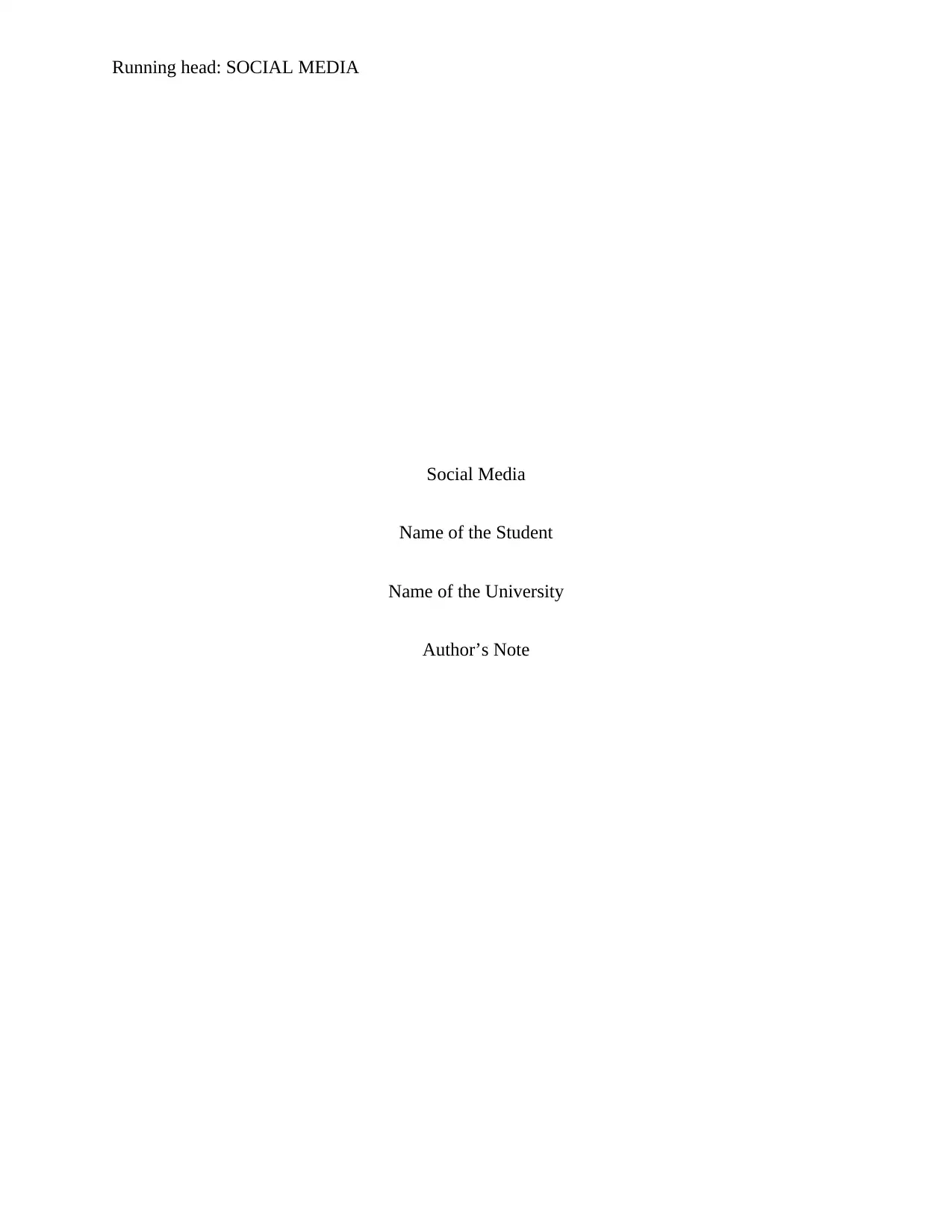
Running head: SOCIAL MEDIA
Social Media
Name of the Student
Name of the University
Author’s Note
Social Media
Name of the Student
Name of the University
Author’s Note
Paraphrase This Document
Need a fresh take? Get an instant paraphrase of this document with our AI Paraphraser
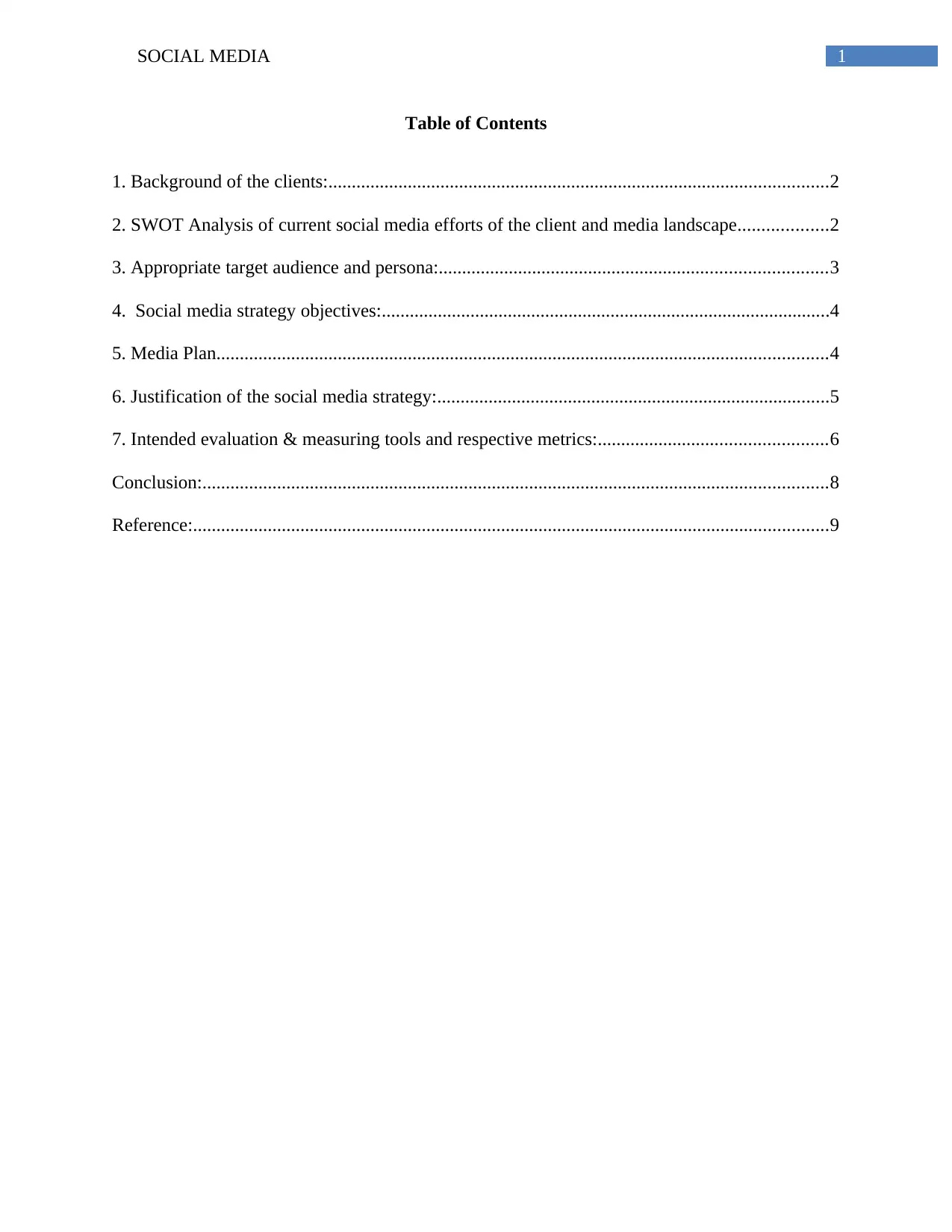
1SOCIAL MEDIA
Table of Contents
1. Background of the clients:...........................................................................................................2
2. SWOT Analysis of current social media efforts of the client and media landscape...................2
3. Appropriate target audience and persona:...................................................................................3
4. Social media strategy objectives:................................................................................................4
5. Media Plan...................................................................................................................................4
6. Justification of the social media strategy:....................................................................................5
7. Intended evaluation & measuring tools and respective metrics:.................................................6
Conclusion:......................................................................................................................................8
Reference:........................................................................................................................................9
Table of Contents
1. Background of the clients:...........................................................................................................2
2. SWOT Analysis of current social media efforts of the client and media landscape...................2
3. Appropriate target audience and persona:...................................................................................3
4. Social media strategy objectives:................................................................................................4
5. Media Plan...................................................................................................................................4
6. Justification of the social media strategy:....................................................................................5
7. Intended evaluation & measuring tools and respective metrics:.................................................6
Conclusion:......................................................................................................................................8
Reference:........................................................................................................................................9
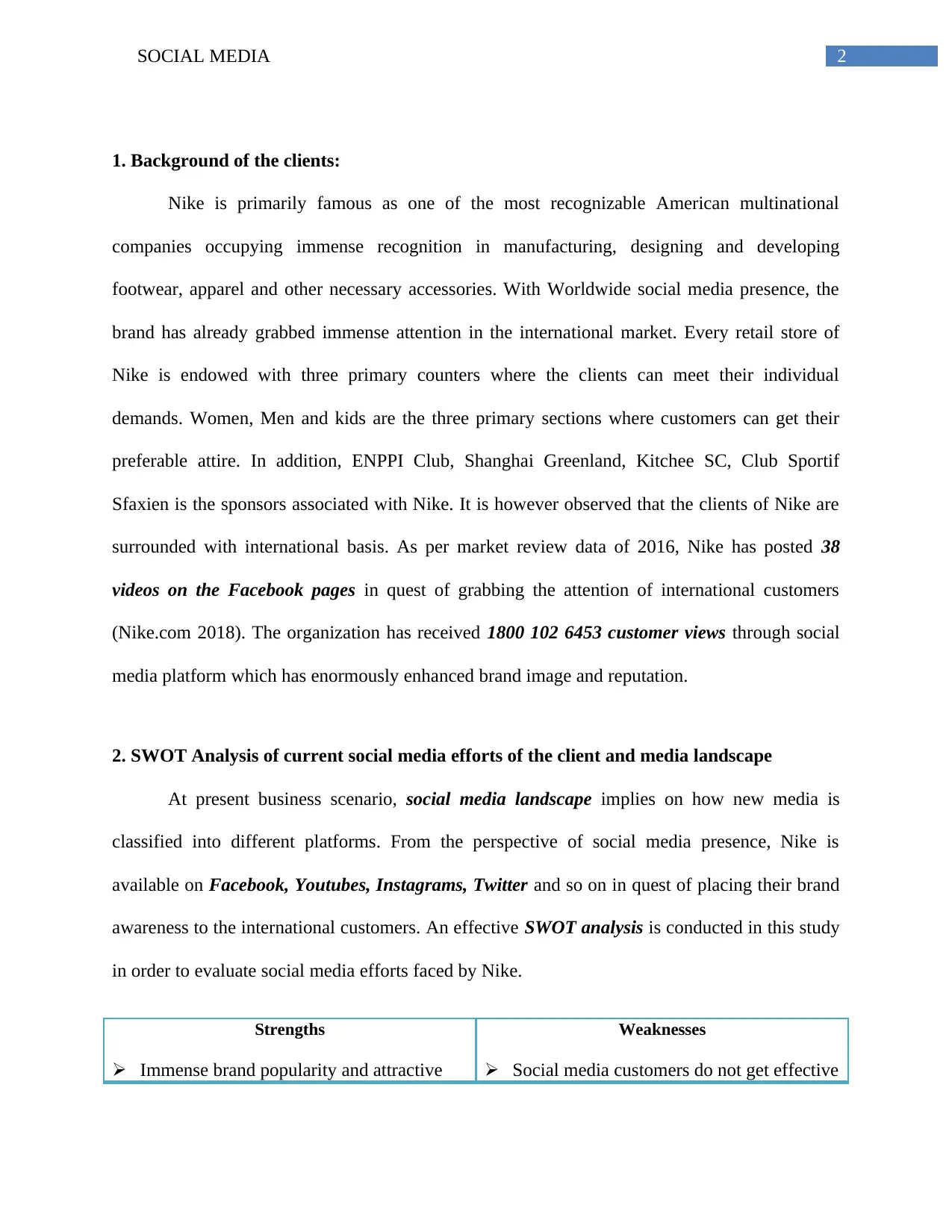
2SOCIAL MEDIA
1. Background of the clients:
Nike is primarily famous as one of the most recognizable American multinational
companies occupying immense recognition in manufacturing, designing and developing
footwear, apparel and other necessary accessories. With Worldwide social media presence, the
brand has already grabbed immense attention in the international market. Every retail store of
Nike is endowed with three primary counters where the clients can meet their individual
demands. Women, Men and kids are the three primary sections where customers can get their
preferable attire. In addition, ENPPI Club, Shanghai Greenland, Kitchee SC, Club Sportif
Sfaxien is the sponsors associated with Nike. It is however observed that the clients of Nike are
surrounded with international basis. As per market review data of 2016, Nike has posted 38
videos on the Facebook pages in quest of grabbing the attention of international customers
(Nike.com 2018). The organization has received 1800 102 6453 customer views through social
media platform which has enormously enhanced brand image and reputation.
2. SWOT Analysis of current social media efforts of the client and media landscape
At present business scenario, social media landscape implies on how new media is
classified into different platforms. From the perspective of social media presence, Nike is
available on Facebook, Youtubes, Instagrams, Twitter and so on in quest of placing their brand
awareness to the international customers. An effective SWOT analysis is conducted in this study
in order to evaluate social media efforts faced by Nike.
Strengths
Immense brand popularity and attractive
Weaknesses
Social media customers do not get effective
1. Background of the clients:
Nike is primarily famous as one of the most recognizable American multinational
companies occupying immense recognition in manufacturing, designing and developing
footwear, apparel and other necessary accessories. With Worldwide social media presence, the
brand has already grabbed immense attention in the international market. Every retail store of
Nike is endowed with three primary counters where the clients can meet their individual
demands. Women, Men and kids are the three primary sections where customers can get their
preferable attire. In addition, ENPPI Club, Shanghai Greenland, Kitchee SC, Club Sportif
Sfaxien is the sponsors associated with Nike. It is however observed that the clients of Nike are
surrounded with international basis. As per market review data of 2016, Nike has posted 38
videos on the Facebook pages in quest of grabbing the attention of international customers
(Nike.com 2018). The organization has received 1800 102 6453 customer views through social
media platform which has enormously enhanced brand image and reputation.
2. SWOT Analysis of current social media efforts of the client and media landscape
At present business scenario, social media landscape implies on how new media is
classified into different platforms. From the perspective of social media presence, Nike is
available on Facebook, Youtubes, Instagrams, Twitter and so on in quest of placing their brand
awareness to the international customers. An effective SWOT analysis is conducted in this study
in order to evaluate social media efforts faced by Nike.
Strengths
Immense brand popularity and attractive
Weaknesses
Social media customers do not get effective
⊘ This is a preview!⊘
Do you want full access?
Subscribe today to unlock all pages.

Trusted by 1+ million students worldwide
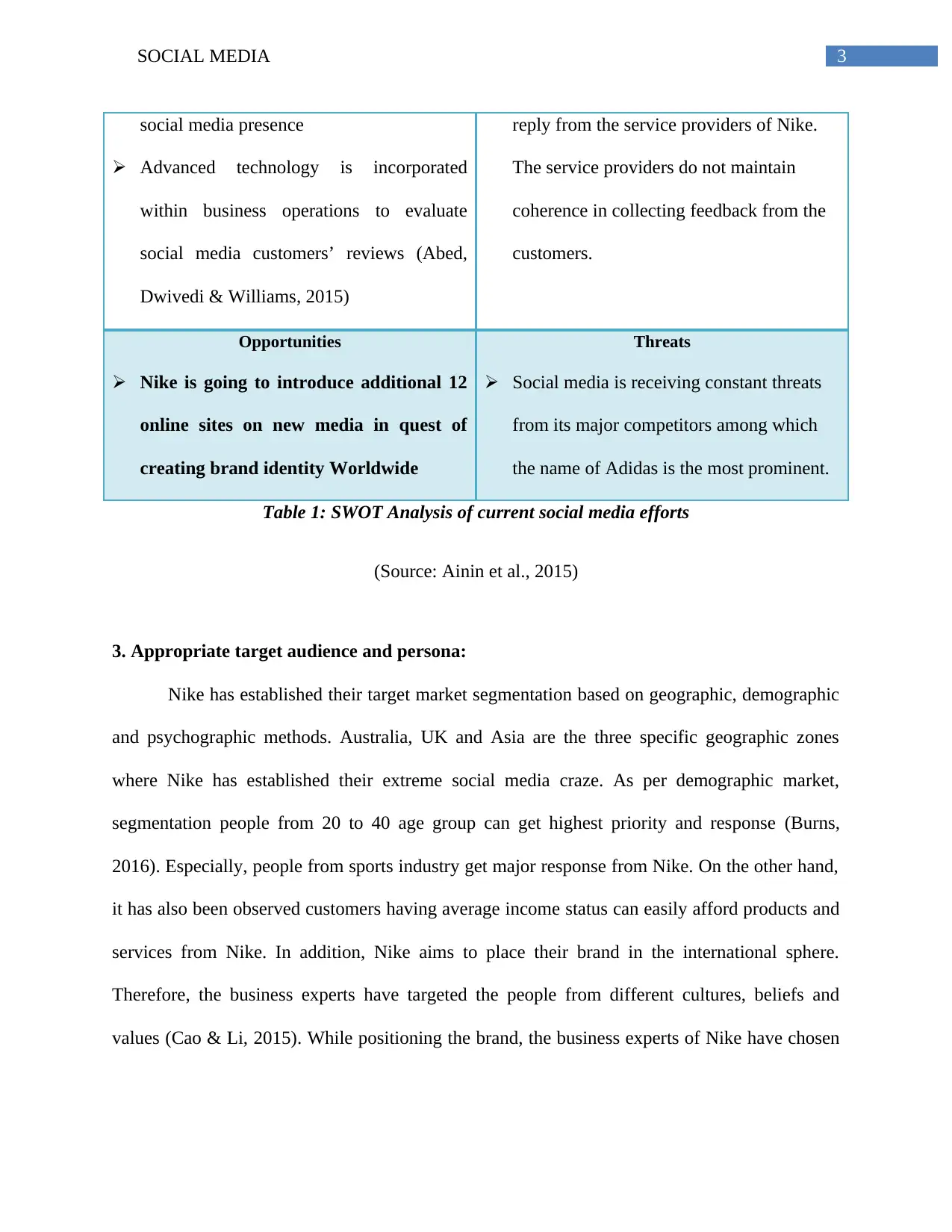
3SOCIAL MEDIA
social media presence
Advanced technology is incorporated
within business operations to evaluate
social media customers’ reviews (Abed,
Dwivedi & Williams, 2015)
reply from the service providers of Nike.
The service providers do not maintain
coherence in collecting feedback from the
customers.
Opportunities
Nike is going to introduce additional 12
online sites on new media in quest of
creating brand identity Worldwide
Threats
Social media is receiving constant threats
from its major competitors among which
the name of Adidas is the most prominent.
Table 1: SWOT Analysis of current social media efforts
(Source: Ainin et al., 2015)
3. Appropriate target audience and persona:
Nike has established their target market segmentation based on geographic, demographic
and psychographic methods. Australia, UK and Asia are the three specific geographic zones
where Nike has established their extreme social media craze. As per demographic market,
segmentation people from 20 to 40 age group can get highest priority and response (Burns,
2016). Especially, people from sports industry get major response from Nike. On the other hand,
it has also been observed customers having average income status can easily afford products and
services from Nike. In addition, Nike aims to place their brand in the international sphere.
Therefore, the business experts have targeted the people from different cultures, beliefs and
values (Cao & Li, 2015). While positioning the brand, the business experts of Nike have chosen
social media presence
Advanced technology is incorporated
within business operations to evaluate
social media customers’ reviews (Abed,
Dwivedi & Williams, 2015)
reply from the service providers of Nike.
The service providers do not maintain
coherence in collecting feedback from the
customers.
Opportunities
Nike is going to introduce additional 12
online sites on new media in quest of
creating brand identity Worldwide
Threats
Social media is receiving constant threats
from its major competitors among which
the name of Adidas is the most prominent.
Table 1: SWOT Analysis of current social media efforts
(Source: Ainin et al., 2015)
3. Appropriate target audience and persona:
Nike has established their target market segmentation based on geographic, demographic
and psychographic methods. Australia, UK and Asia are the three specific geographic zones
where Nike has established their extreme social media craze. As per demographic market,
segmentation people from 20 to 40 age group can get highest priority and response (Burns,
2016). Especially, people from sports industry get major response from Nike. On the other hand,
it has also been observed customers having average income status can easily afford products and
services from Nike. In addition, Nike aims to place their brand in the international sphere.
Therefore, the business experts have targeted the people from different cultures, beliefs and
values (Cao & Li, 2015). While positioning the brand, the business experts of Nike have chosen
Paraphrase This Document
Need a fresh take? Get an instant paraphrase of this document with our AI Paraphraser
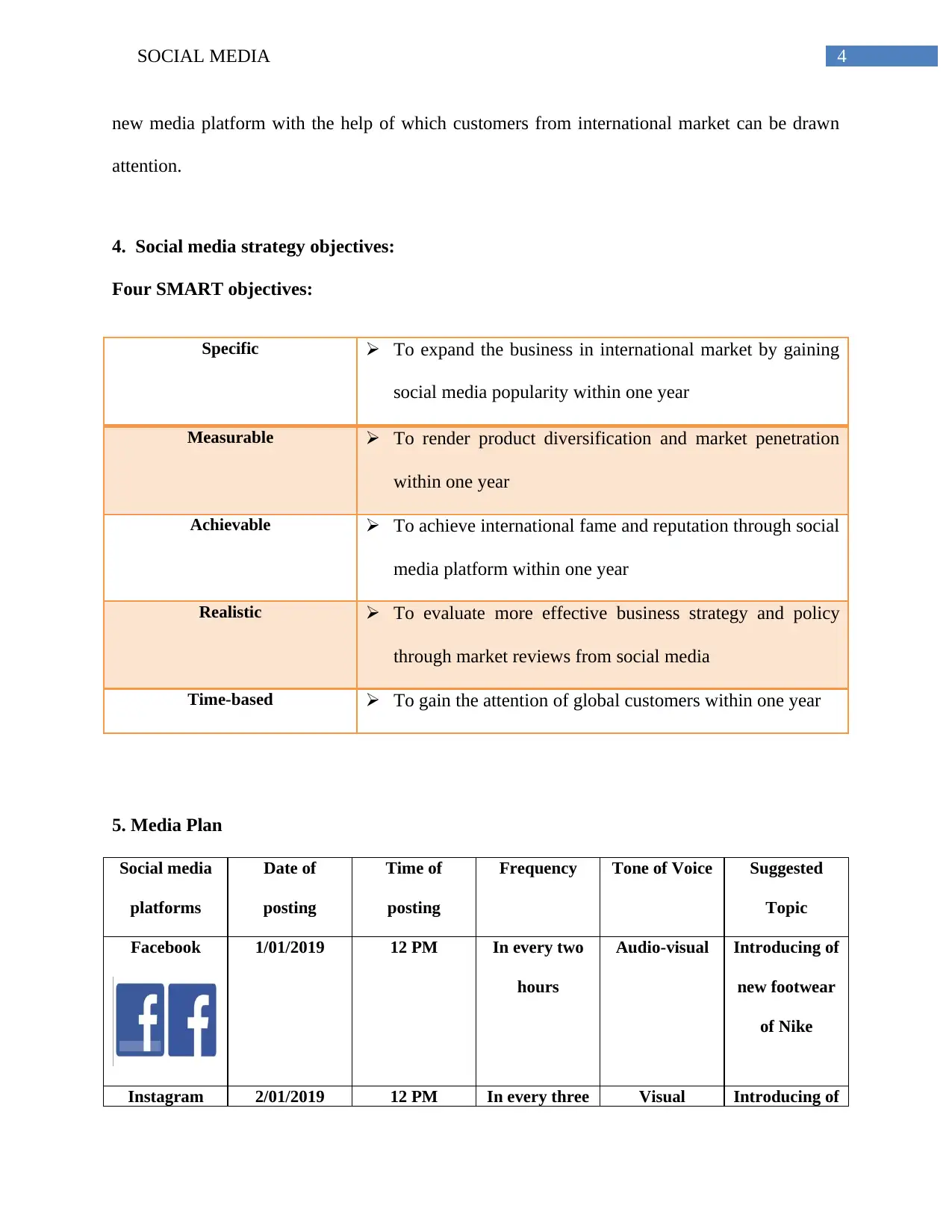
4SOCIAL MEDIA
new media platform with the help of which customers from international market can be drawn
attention.
4. Social media strategy objectives:
Four SMART objectives:
Specific To expand the business in international market by gaining
social media popularity within one year
Measurable To render product diversification and market penetration
within one year
Achievable To achieve international fame and reputation through social
media platform within one year
Realistic To evaluate more effective business strategy and policy
through market reviews from social media
Time-based To gain the attention of global customers within one year
5. Media Plan
Social media
platforms
Date of
posting
Time of
posting
Frequency Tone of Voice Suggested
Topic
Facebook 1/01/2019 12 PM In every two
hours
Audio-visual Introducing of
new footwear
of Nike
Instagram 2/01/2019 12 PM In every three Visual Introducing of
new media platform with the help of which customers from international market can be drawn
attention.
4. Social media strategy objectives:
Four SMART objectives:
Specific To expand the business in international market by gaining
social media popularity within one year
Measurable To render product diversification and market penetration
within one year
Achievable To achieve international fame and reputation through social
media platform within one year
Realistic To evaluate more effective business strategy and policy
through market reviews from social media
Time-based To gain the attention of global customers within one year
5. Media Plan
Social media
platforms
Date of
posting
Time of
posting
Frequency Tone of Voice Suggested
Topic
Facebook 1/01/2019 12 PM In every two
hours
Audio-visual Introducing of
new footwear
of Nike
Instagram 2/01/2019 12 PM In every three Visual Introducing of
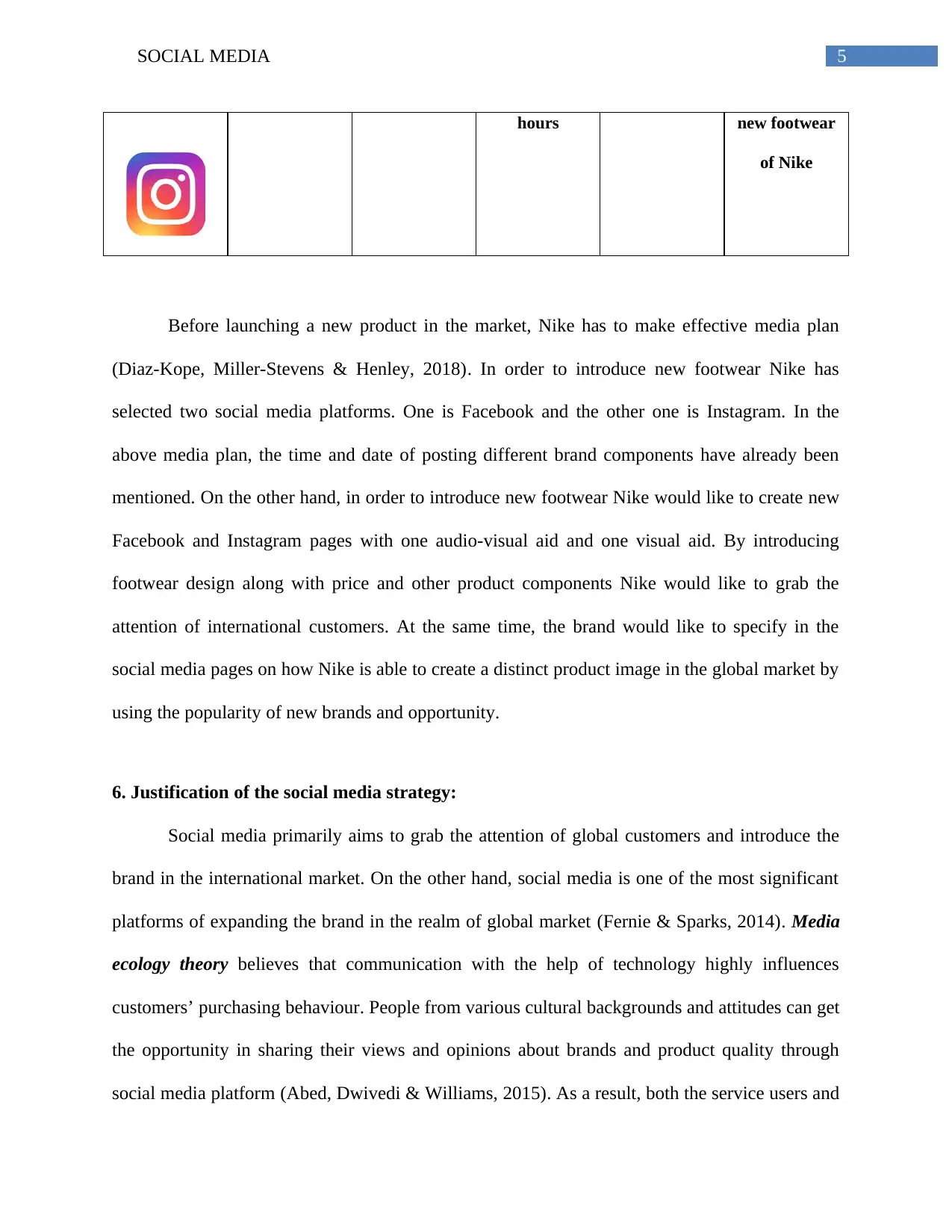
5SOCIAL MEDIA
hours new footwear
of Nike
Before launching a new product in the market, Nike has to make effective media plan
(Diaz-Kope, Miller-Stevens & Henley, 2018). In order to introduce new footwear Nike has
selected two social media platforms. One is Facebook and the other one is Instagram. In the
above media plan, the time and date of posting different brand components have already been
mentioned. On the other hand, in order to introduce new footwear Nike would like to create new
Facebook and Instagram pages with one audio-visual aid and one visual aid. By introducing
footwear design along with price and other product components Nike would like to grab the
attention of international customers. At the same time, the brand would like to specify in the
social media pages on how Nike is able to create a distinct product image in the global market by
using the popularity of new brands and opportunity.
6. Justification of the social media strategy:
Social media primarily aims to grab the attention of global customers and introduce the
brand in the international market. On the other hand, social media is one of the most significant
platforms of expanding the brand in the realm of global market (Fernie & Sparks, 2014). Media
ecology theory believes that communication with the help of technology highly influences
customers’ purchasing behaviour. People from various cultural backgrounds and attitudes can get
the opportunity in sharing their views and opinions about brands and product quality through
social media platform (Abed, Dwivedi & Williams, 2015). As a result, both the service users and
hours new footwear
of Nike
Before launching a new product in the market, Nike has to make effective media plan
(Diaz-Kope, Miller-Stevens & Henley, 2018). In order to introduce new footwear Nike has
selected two social media platforms. One is Facebook and the other one is Instagram. In the
above media plan, the time and date of posting different brand components have already been
mentioned. On the other hand, in order to introduce new footwear Nike would like to create new
Facebook and Instagram pages with one audio-visual aid and one visual aid. By introducing
footwear design along with price and other product components Nike would like to grab the
attention of international customers. At the same time, the brand would like to specify in the
social media pages on how Nike is able to create a distinct product image in the global market by
using the popularity of new brands and opportunity.
6. Justification of the social media strategy:
Social media primarily aims to grab the attention of global customers and introduce the
brand in the international market. On the other hand, social media is one of the most significant
platforms of expanding the brand in the realm of global market (Fernie & Sparks, 2014). Media
ecology theory believes that communication with the help of technology highly influences
customers’ purchasing behaviour. People from various cultural backgrounds and attitudes can get
the opportunity in sharing their views and opinions about brands and product quality through
social media platform (Abed, Dwivedi & Williams, 2015). As a result, both the service users and
⊘ This is a preview!⊘
Do you want full access?
Subscribe today to unlock all pages.

Trusted by 1+ million students worldwide
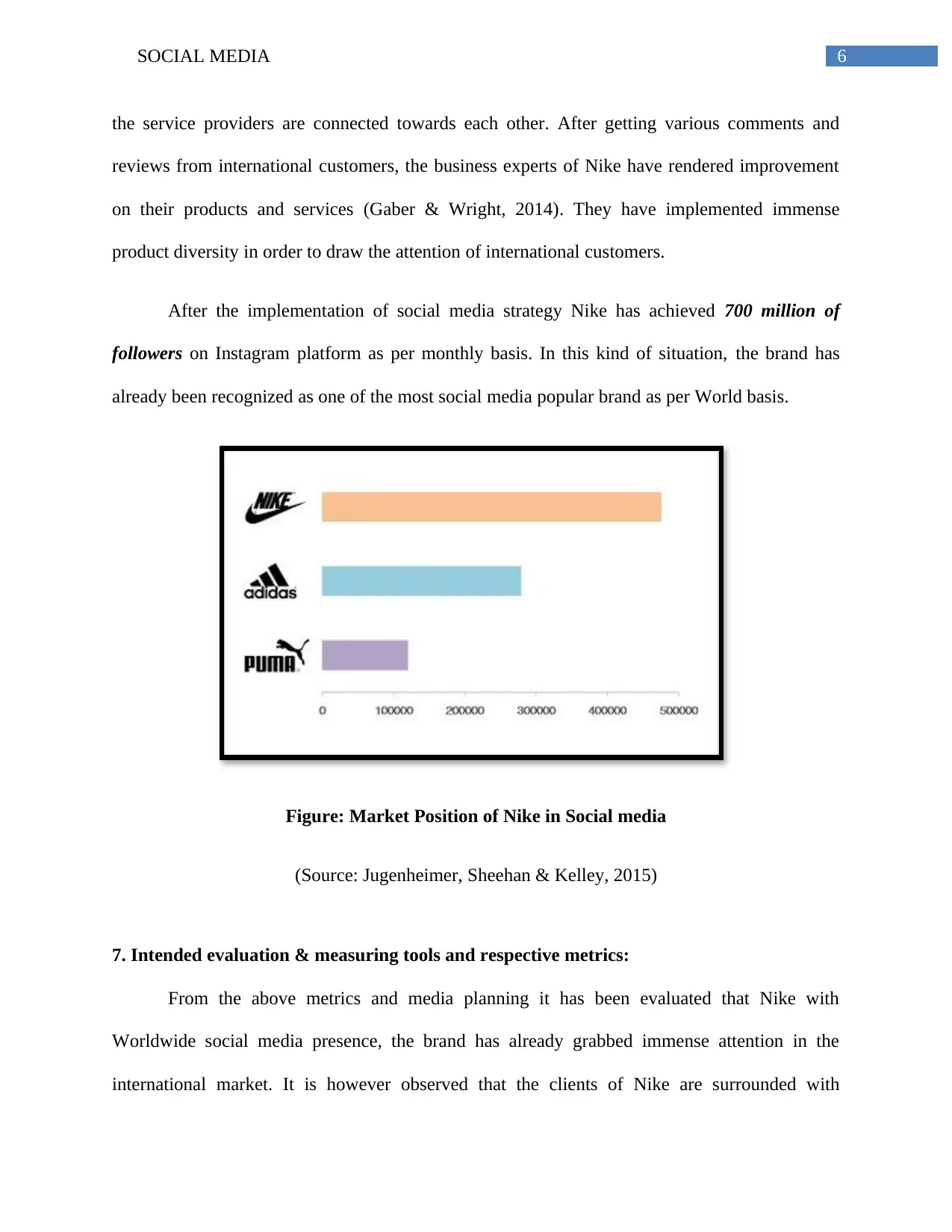
6SOCIAL MEDIA
the service providers are connected towards each other. After getting various comments and
reviews from international customers, the business experts of Nike have rendered improvement
on their products and services (Gaber & Wright, 2014). They have implemented immense
product diversity in order to draw the attention of international customers.
After the implementation of social media strategy Nike has achieved 700 million of
followers on Instagram platform as per monthly basis. In this kind of situation, the brand has
already been recognized as one of the most social media popular brand as per World basis.
Figure: Market Position of Nike in Social media
(Source: Jugenheimer, Sheehan & Kelley, 2015)
7. Intended evaluation & measuring tools and respective metrics:
From the above metrics and media planning it has been evaluated that Nike with
Worldwide social media presence, the brand has already grabbed immense attention in the
international market. It is however observed that the clients of Nike are surrounded with
the service providers are connected towards each other. After getting various comments and
reviews from international customers, the business experts of Nike have rendered improvement
on their products and services (Gaber & Wright, 2014). They have implemented immense
product diversity in order to draw the attention of international customers.
After the implementation of social media strategy Nike has achieved 700 million of
followers on Instagram platform as per monthly basis. In this kind of situation, the brand has
already been recognized as one of the most social media popular brand as per World basis.
Figure: Market Position of Nike in Social media
(Source: Jugenheimer, Sheehan & Kelley, 2015)
7. Intended evaluation & measuring tools and respective metrics:
From the above metrics and media planning it has been evaluated that Nike with
Worldwide social media presence, the brand has already grabbed immense attention in the
international market. It is however observed that the clients of Nike are surrounded with
Paraphrase This Document
Need a fresh take? Get an instant paraphrase of this document with our AI Paraphraser
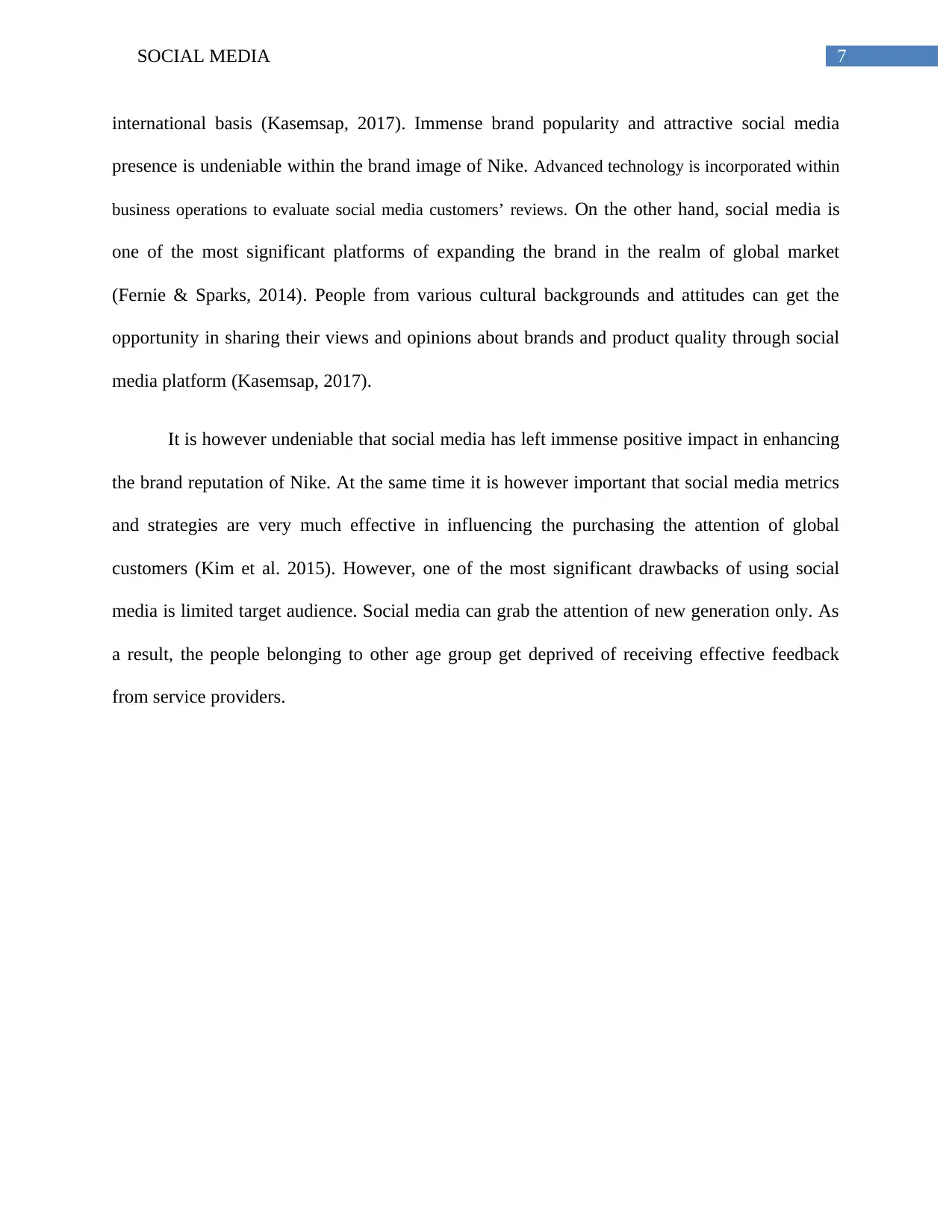
7SOCIAL MEDIA
international basis (Kasemsap, 2017). Immense brand popularity and attractive social media
presence is undeniable within the brand image of Nike. Advanced technology is incorporated within
business operations to evaluate social media customers’ reviews. On the other hand, social media is
one of the most significant platforms of expanding the brand in the realm of global market
(Fernie & Sparks, 2014). People from various cultural backgrounds and attitudes can get the
opportunity in sharing their views and opinions about brands and product quality through social
media platform (Kasemsap, 2017).
It is however undeniable that social media has left immense positive impact in enhancing
the brand reputation of Nike. At the same time it is however important that social media metrics
and strategies are very much effective in influencing the purchasing the attention of global
customers (Kim et al. 2015). However, one of the most significant drawbacks of using social
media is limited target audience. Social media can grab the attention of new generation only. As
a result, the people belonging to other age group get deprived of receiving effective feedback
from service providers.
international basis (Kasemsap, 2017). Immense brand popularity and attractive social media
presence is undeniable within the brand image of Nike. Advanced technology is incorporated within
business operations to evaluate social media customers’ reviews. On the other hand, social media is
one of the most significant platforms of expanding the brand in the realm of global market
(Fernie & Sparks, 2014). People from various cultural backgrounds and attitudes can get the
opportunity in sharing their views and opinions about brands and product quality through social
media platform (Kasemsap, 2017).
It is however undeniable that social media has left immense positive impact in enhancing
the brand reputation of Nike. At the same time it is however important that social media metrics
and strategies are very much effective in influencing the purchasing the attention of global
customers (Kim et al. 2015). However, one of the most significant drawbacks of using social
media is limited target audience. Social media can grab the attention of new generation only. As
a result, the people belonging to other age group get deprived of receiving effective feedback
from service providers.
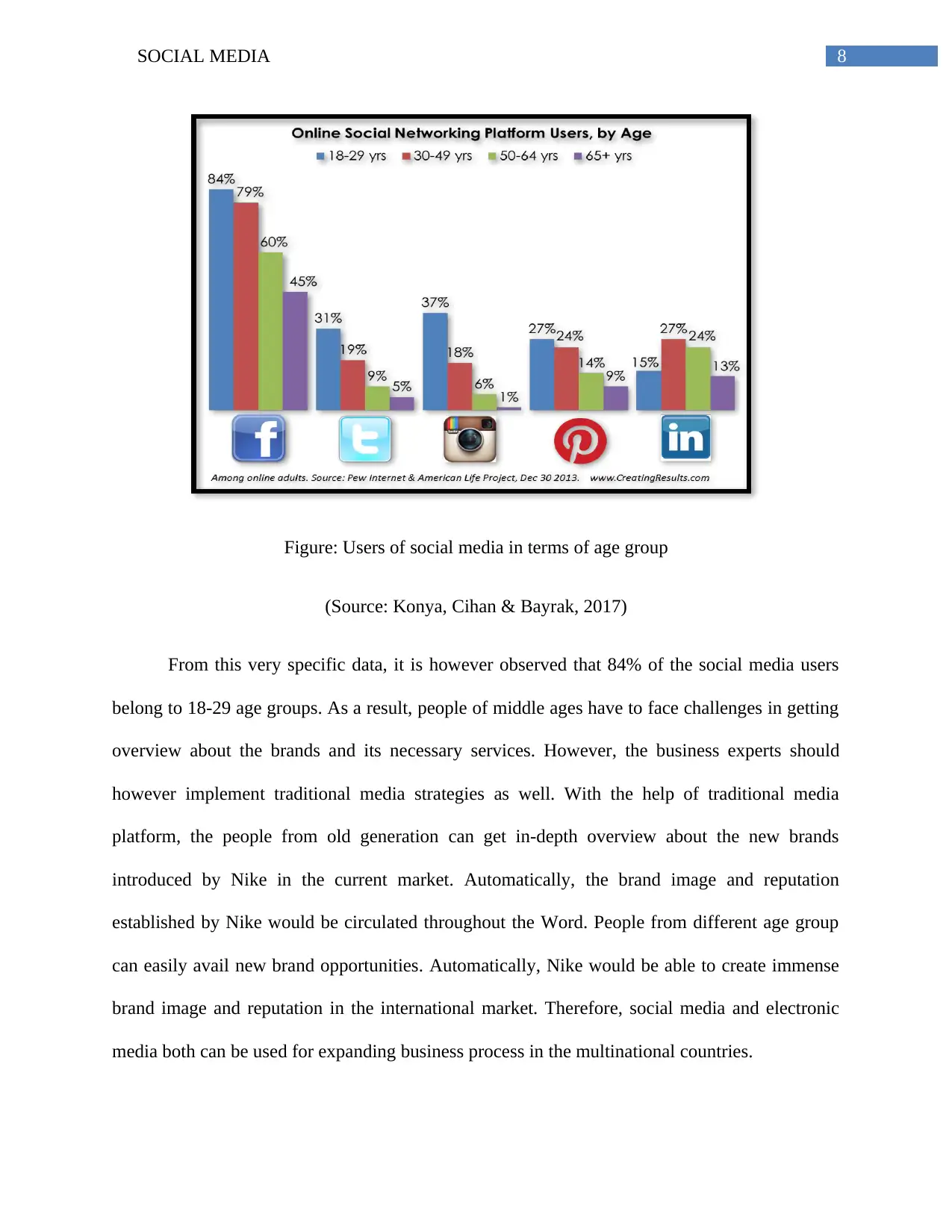
8SOCIAL MEDIA
Figure: Users of social media in terms of age group
(Source: Konya, Cihan & Bayrak, 2017)
From this very specific data, it is however observed that 84% of the social media users
belong to 18-29 age groups. As a result, people of middle ages have to face challenges in getting
overview about the brands and its necessary services. However, the business experts should
however implement traditional media strategies as well. With the help of traditional media
platform, the people from old generation can get in-depth overview about the new brands
introduced by Nike in the current market. Automatically, the brand image and reputation
established by Nike would be circulated throughout the Word. People from different age group
can easily avail new brand opportunities. Automatically, Nike would be able to create immense
brand image and reputation in the international market. Therefore, social media and electronic
media both can be used for expanding business process in the multinational countries.
Figure: Users of social media in terms of age group
(Source: Konya, Cihan & Bayrak, 2017)
From this very specific data, it is however observed that 84% of the social media users
belong to 18-29 age groups. As a result, people of middle ages have to face challenges in getting
overview about the brands and its necessary services. However, the business experts should
however implement traditional media strategies as well. With the help of traditional media
platform, the people from old generation can get in-depth overview about the new brands
introduced by Nike in the current market. Automatically, the brand image and reputation
established by Nike would be circulated throughout the Word. People from different age group
can easily avail new brand opportunities. Automatically, Nike would be able to create immense
brand image and reputation in the international market. Therefore, social media and electronic
media both can be used for expanding business process in the multinational countries.
⊘ This is a preview!⊘
Do you want full access?
Subscribe today to unlock all pages.

Trusted by 1+ million students worldwide
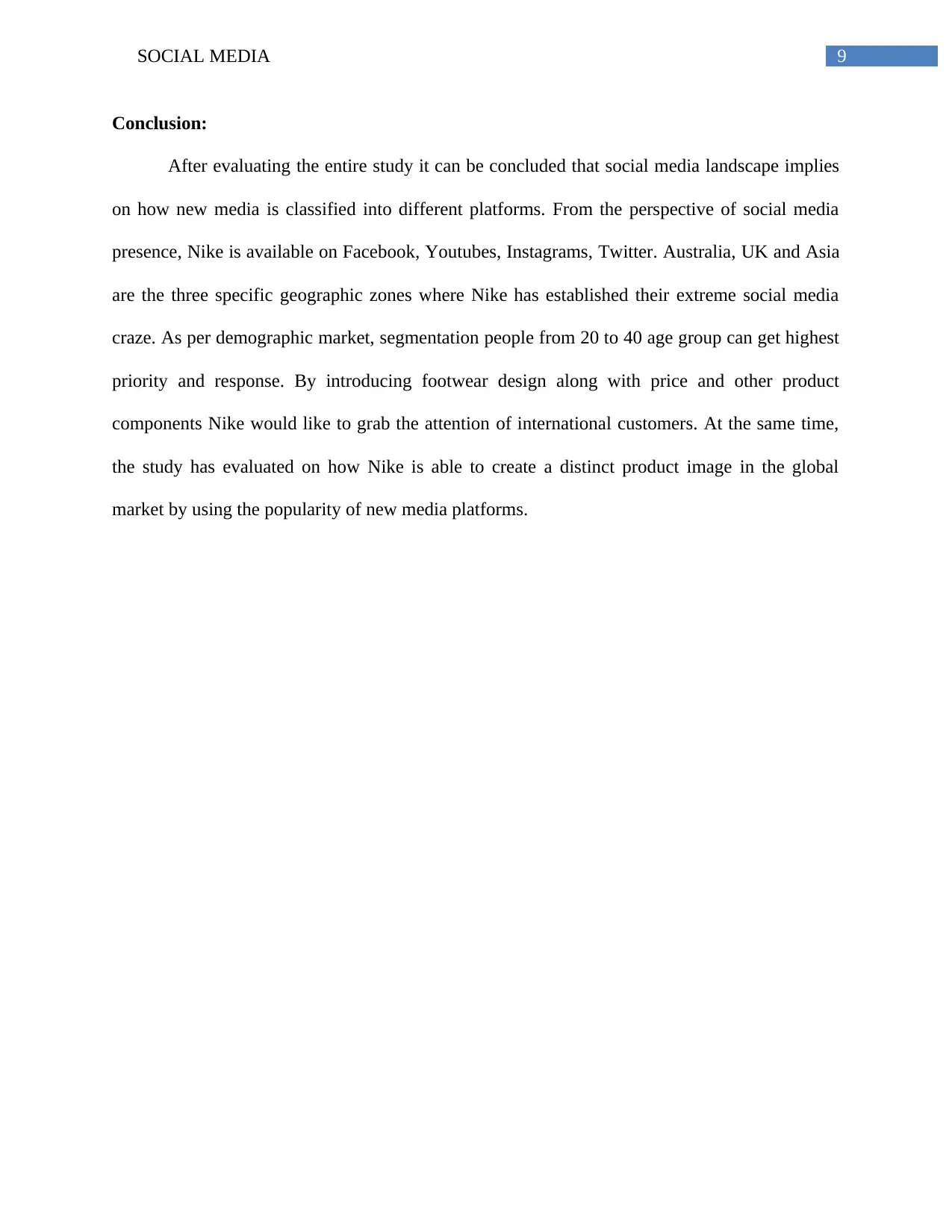
9SOCIAL MEDIA
Conclusion:
After evaluating the entire study it can be concluded that social media landscape implies
on how new media is classified into different platforms. From the perspective of social media
presence, Nike is available on Facebook, Youtubes, Instagrams, Twitter. Australia, UK and Asia
are the three specific geographic zones where Nike has established their extreme social media
craze. As per demographic market, segmentation people from 20 to 40 age group can get highest
priority and response. By introducing footwear design along with price and other product
components Nike would like to grab the attention of international customers. At the same time,
the study has evaluated on how Nike is able to create a distinct product image in the global
market by using the popularity of new media platforms.
Conclusion:
After evaluating the entire study it can be concluded that social media landscape implies
on how new media is classified into different platforms. From the perspective of social media
presence, Nike is available on Facebook, Youtubes, Instagrams, Twitter. Australia, UK and Asia
are the three specific geographic zones where Nike has established their extreme social media
craze. As per demographic market, segmentation people from 20 to 40 age group can get highest
priority and response. By introducing footwear design along with price and other product
components Nike would like to grab the attention of international customers. At the same time,
the study has evaluated on how Nike is able to create a distinct product image in the global
market by using the popularity of new media platforms.
Paraphrase This Document
Need a fresh take? Get an instant paraphrase of this document with our AI Paraphraser
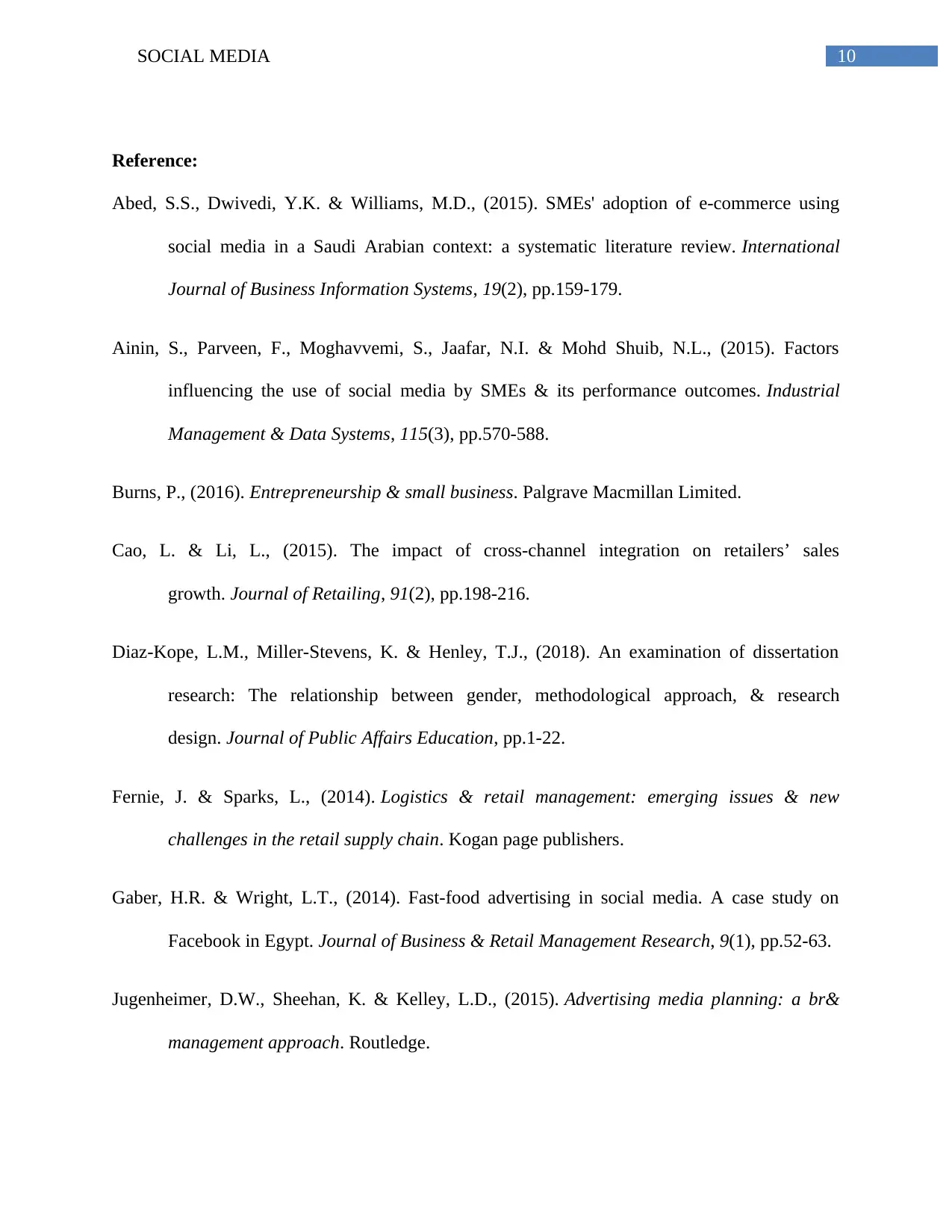
10SOCIAL MEDIA
Reference:
Abed, S.S., Dwivedi, Y.K. & Williams, M.D., (2015). SMEs' adoption of e-commerce using
social media in a Saudi Arabian context: a systematic literature review. International
Journal of Business Information Systems, 19(2), pp.159-179.
Ainin, S., Parveen, F., Moghavvemi, S., Jaafar, N.I. & Mohd Shuib, N.L., (2015). Factors
influencing the use of social media by SMEs & its performance outcomes. Industrial
Management & Data Systems, 115(3), pp.570-588.
Burns, P., (2016). Entrepreneurship & small business. Palgrave Macmillan Limited.
Cao, L. & Li, L., (2015). The impact of cross-channel integration on retailers’ sales
growth. Journal of Retailing, 91(2), pp.198-216.
Diaz-Kope, L.M., Miller-Stevens, K. & Henley, T.J., (2018). An examination of dissertation
research: The relationship between gender, methodological approach, & research
design. Journal of Public Affairs Education, pp.1-22.
Fernie, J. & Sparks, L., (2014). Logistics & retail management: emerging issues & new
challenges in the retail supply chain. Kogan page publishers.
Gaber, H.R. & Wright, L.T., (2014). Fast-food advertising in social media. A case study on
Facebook in Egypt. Journal of Business & Retail Management Research, 9(1), pp.52-63.
Jugenheimer, D.W., Sheehan, K. & Kelley, L.D., (2015). Advertising media planning: a br&
management approach. Routledge.
Reference:
Abed, S.S., Dwivedi, Y.K. & Williams, M.D., (2015). SMEs' adoption of e-commerce using
social media in a Saudi Arabian context: a systematic literature review. International
Journal of Business Information Systems, 19(2), pp.159-179.
Ainin, S., Parveen, F., Moghavvemi, S., Jaafar, N.I. & Mohd Shuib, N.L., (2015). Factors
influencing the use of social media by SMEs & its performance outcomes. Industrial
Management & Data Systems, 115(3), pp.570-588.
Burns, P., (2016). Entrepreneurship & small business. Palgrave Macmillan Limited.
Cao, L. & Li, L., (2015). The impact of cross-channel integration on retailers’ sales
growth. Journal of Retailing, 91(2), pp.198-216.
Diaz-Kope, L.M., Miller-Stevens, K. & Henley, T.J., (2018). An examination of dissertation
research: The relationship between gender, methodological approach, & research
design. Journal of Public Affairs Education, pp.1-22.
Fernie, J. & Sparks, L., (2014). Logistics & retail management: emerging issues & new
challenges in the retail supply chain. Kogan page publishers.
Gaber, H.R. & Wright, L.T., (2014). Fast-food advertising in social media. A case study on
Facebook in Egypt. Journal of Business & Retail Management Research, 9(1), pp.52-63.
Jugenheimer, D.W., Sheehan, K. & Kelley, L.D., (2015). Advertising media planning: a br&
management approach. Routledge.
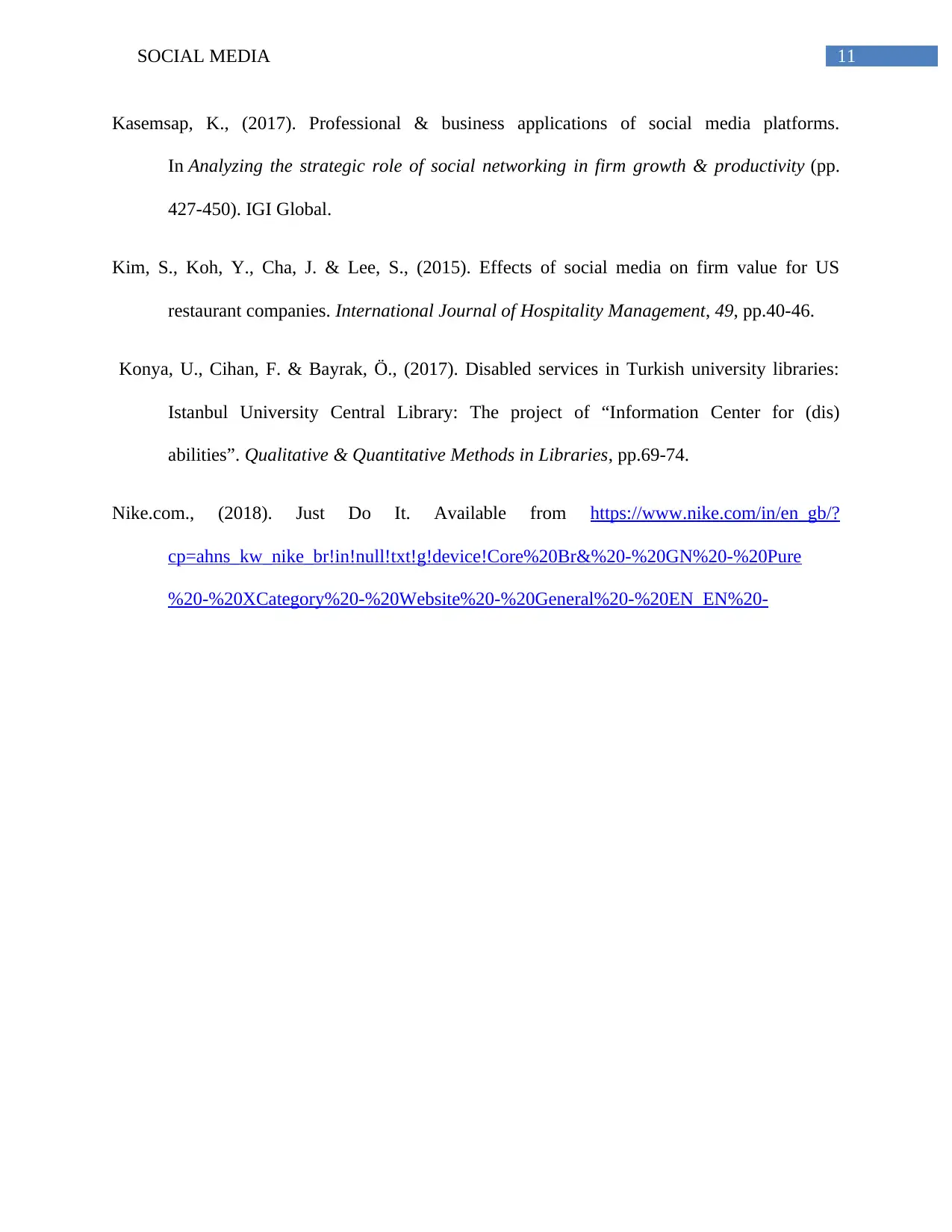
11SOCIAL MEDIA
Kasemsap, K., (2017). Professional & business applications of social media platforms.
In Analyzing the strategic role of social networking in firm growth & productivity (pp.
427-450). IGI Global.
Kim, S., Koh, Y., Cha, J. & Lee, S., (2015). Effects of social media on firm value for US
restaurant companies. International Journal of Hospitality Management, 49, pp.40-46.
Konya, U., Cihan, F. & Bayrak, Ö., (2017). Disabled services in Turkish university libraries:
Istanbul University Central Library: The project of “Information Center for (dis)
abilities”. Qualitative & Quantitative Methods in Libraries, pp.69-74.
Nike.com., (2018). Just Do It. Available from https://www.nike.com/in/en_gb/?
cp=ahns_kw_nike_br!in!null!txt!g!device!Core%20Br&%20-%20GN%20-%20Pure
%20-%20XCategory%20-%20Website%20-%20General%20-%20EN_EN%20-
Kasemsap, K., (2017). Professional & business applications of social media platforms.
In Analyzing the strategic role of social networking in firm growth & productivity (pp.
427-450). IGI Global.
Kim, S., Koh, Y., Cha, J. & Lee, S., (2015). Effects of social media on firm value for US
restaurant companies. International Journal of Hospitality Management, 49, pp.40-46.
Konya, U., Cihan, F. & Bayrak, Ö., (2017). Disabled services in Turkish university libraries:
Istanbul University Central Library: The project of “Information Center for (dis)
abilities”. Qualitative & Quantitative Methods in Libraries, pp.69-74.
Nike.com., (2018). Just Do It. Available from https://www.nike.com/in/en_gb/?
cp=ahns_kw_nike_br!in!null!txt!g!device!Core%20Br&%20-%20GN%20-%20Pure
%20-%20XCategory%20-%20Website%20-%20General%20-%20EN_EN%20-
⊘ This is a preview!⊘
Do you want full access?
Subscribe today to unlock all pages.

Trusted by 1+ million students worldwide
1 out of 12
Related Documents
Your All-in-One AI-Powered Toolkit for Academic Success.
+13062052269
info@desklib.com
Available 24*7 on WhatsApp / Email
![[object Object]](/_next/static/media/star-bottom.7253800d.svg)
Unlock your academic potential
Copyright © 2020–2025 A2Z Services. All Rights Reserved. Developed and managed by ZUCOL.





